AdamAnt316
Guest
|
Hello everyone! Not too long ago, I found an old American Electric street light in a neighbor's trashpile. The pole arm is completely missing, as is the wiring which would've connected it to the power supply, so I'm reasonably sure it wasn't just hacked off a telephone pole.  Not sure of the vintage, but the tag inside identifies it as a catalog # 13-1612. I got around to opening the case the other day, and found that it was equipped with a GE R100-series mercury vapor lamp, as well as a two-wire ballast and a three-wire photosensor. The main thing I'm wondering is, how would I go about wiring it up? The terminal block has three screws, labeled LI, N, and LE in the schematic diagram. As can be seen in my crude drawing below, LE goes to one side of the ballast, while both LI and N go to the photosensor, which then connects to the white wire coming from the lamp socket via the sensor's third wire. Which of these am I supposed to connect voltage to, and what sort of voltage is it expecting to see, 120V or 240V? Thanks in advance! -Adam 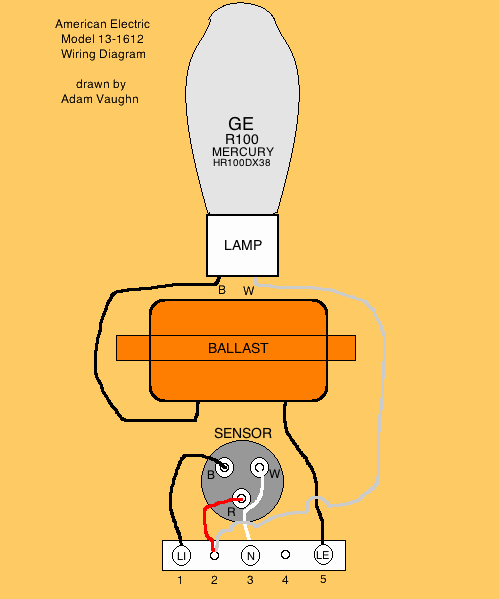 |
|
|
|
 Logged
Logged
|
|
Medved
Member
    
Offline
Gender: 
View
Posts
View Gallery
|
| If it is MV and only with 2 wire ballast, it run on at least 240V, so you would need an autotransformer from 120V (from your profile i understood you are in US).
I guess the correct supply voltage would be 240 or 277V, higher levels (440V,...) would likely use again some sort of autotransformer ballast (so at least 3 wires), as the power factor would be very low, so ballast losses high.
|
|
|
|
 Logged
Logged
|
No more selfballasted c***
|
AdamAnt316
Guest
|
If it is MV and only with 2 wire ballast, it run on at least 240V, so you would need an autotransformer from 120V (from your profile i understood you are in US).
I guess the correct supply voltage would be 240 or 277V, higher levels (440V,...) would likely use again some sort of autotransformer ballast (so at least 3 wires), as the power factor would be very low, so ballast losses high.
Thank you for your response. Yes, I indeed live in the US, so 120V line current is the norm (though we do have 240V coming in, which is mainly used for large appliances like dryers and air conditioners). My question remains, how would I wire it up to a 240V line? I'm guessing that current has to go to both the lamp (via the ballast on terminal LE) and the photosensor (via terminal LI), but how do I supply the current? Also, would it hurt to bypass the photosensor, and attempt to light the bulb on plain 120V? Again, thanks in advance. -Adam |
|
|
« Last Edit: January 11, 2011, 03:50:22 PM by AdamAnt316 »
|
 Logged
Logged
|
|
lite_lover
Member
   
Offline
Gender: 
View
Posts
View Gallery

Darren
 
|
| Hi Adam, by your description you have a nice American Electric Model 13 fixture with a reactor ballast,I'm assuming it's a 120V fixture if there isn't any label stating supply voltage inside.If you don't have a photocontrol on the fixture just connect your power supply to LE and move the white socket wire to N terminal and connect your other supply wire to N and that should work,to operate with a photocontrol you need to change a couple wires,the red wire from photocontrol receptacle should go to LE and the white wire that goes to the socket should go to N (neutral) then connect your power to L1 and the N (neutral).
Regards,
Darren
|
|
|
|
 Logged
Logged
|
The brighter the better.
|
Medved
Member
    
Offline
Gender: 
View
Posts
View Gallery
|
| @Darren: I don't think MV is able to work on reactor ballast on 120V, as MV100W (H38) has arc voltage abut 115V, while the ballast OCV (what equal to the mains on serial reactor) should be about twice the arc voltage, so at least 200V.
On 120V it will likely cycle (as cold lamp has lower arc voltage, so would be able to sustain the arc) or does not start at all (120V would not be able to ignite it), but you may try, i recommend to use an A-metter, normally the current should settle at ~0.95A, but initially it would be higher...
If you see initially way lower current, the ballast is for higher mains voltage.
|
|
|
|
 Logged
Logged
|
No more selfballasted c***
|
AdamAnt316
Guest
|
| Again, thanks for the replies! I tried wiring the neutral from my cheater cord to the neutral wire of the bulb using a jumper going across pins 2 and 3 of the terminal block. Unfortunately, I don't seem to get any reaction whatsoever from the bulb or the ballast (figured I'd at least get a hum) after a minute of having it plugged in. I'll have to try again using an AC ammeter to see what sort of current draw, if any, I'm getting from the unit at 120V, but I have a feeling that I either need to switch to 240V current, or figure out what part of the circuit isn't working.
-Adam
|
|
|
|
 Logged
Logged
|
|
lite_lover
Member
   
Offline
Gender: 
View
Posts
View Gallery

Darren
 
|
| Is there a label or any printing on the ballast? It could be on the bottom, you may have to loosen the ballast and take a look underneath.Yes it's best to start with 120V before trying with 240V. Did the fixture include a photocontrol and if so what colour is it?
|
|
|
|
 Logged
Logged
|
The brighter the better.
|
AdamAnt316
Guest
|
| There's no printing that I could see on either side of the ballast. I'll try removing it later on, and seeing if there's any printing on the bottom, but it's hard to tell where it could be. There is indeed a photocontrol installed, though the cover over it has seen far better days. It looks to be some sort of grayish-beige color, though it could be faded from something else. As mentioned in my first post, it has three wires coming from it, one which appears to be AC in (black), one which is neutral in from the power line (white), and one which is neutral out to the MV lamp (red).
Anyway, I tried to get it to light yet again. In nearly complete darkness, I'm seeing no noticeable light coming from the bulb itself, and hearing no discernable humming sound from the ballast. I measured the voltage across the 'output' terminal of the reactor ballast and the neutral line which I jumpered, and got approximately the same reading as the line voltage. I haven't tried using an AC ammeter as of yet, though I intend to soon. I'll also take some photos of the fixture soon.
-Adam
|
|
|
|
 Logged
Logged
|
|
lite_lover
Member
   
Offline
Gender: 
View
Posts
View Gallery

Darren
 
|
| Hi Adam, the colour of the photocontrol is telling me that it is 120V being a grayish colour,you can pull it out and see if there is a label on the bottom indicating the voltage.It appears the 3 wire photocontrol wiring might not be right,black is power supply,white is neutral and red is power supply output to ballast.The black wire from the ballast should go to the red PC wire and the white PC wire and white lamp socket wire together with your neutral in.The AC in is the black PC wire.
|
|
|
|
 Logged
Logged
|
The brighter the better.
|
AdamAnt316
Guest
|
Hi Adam, the colour of the photocontrol is telling me that it is 120V being a grayish colour,you can pull it out and see if there is a label on the bottom indicating the voltage.It appears the 3 wire photocontrol wiring might not be right,black is power supply,white is neutral and red is power supply output to ballast.The black wire from the ballast should go to the red PC wire and the white PC wire and white lamp socket wire together with your neutral in.The AC in is the black PC wire.
Good to know. I'll have to see if the photocontrol can be extracted without destroying what's left of it's cover. However, the way it's wired now is how it was wired when I got it, and several of the wires are frozen to the connectors on the back part of the terminal block, so I think it's been this way for a very long time. Also, when I tried to get the bulb to ignite, it was with a jumper lead connected from pins 2 to 3, allowing the neutral lead from the power cord to get to the neutral lead going to the bulb, without having to go through a powered-up photocontrol. Granted, I did so without taking the white and red leads from the photocontrol out-of-circuit, though some voltage was getting to the ballast, so I dunno exactly what's going on here. -Adam |
|
|
|
 Logged
Logged
|
|
lite_lover
Member
   
Offline
Gender: 
View
Posts
View Gallery

Darren
 
|
Hopefully the photocontrol is not seized in it's plug-in receptacle,it should be possible to twist it back and forth approx 3/8 of an inch to see if it's free,it should pull straight out when it's turned fully counter-clockwise.Some penentrating lubricant such as liquid wrench sprayed onto the terminals may help to loosen the frozen connectors. Click here to view the photocontrol's 3 prong twist-lock blades. |
|
|
« Last Edit: January 11, 2011, 10:40:43 PM by lite_lover »
|
 Logged
Logged
|
The brighter the better.
|
AdamAnt316
Guest
|
| Bump from the future!
I finally got around to removing the photocontrol (fairly easy, considering it's likely age), and looked at the bottom. This is what the large sticker says:
6690C
1000W - 1800VA
105-285V 50-60Hz
Seems to be a rather flexible photocontrol. Does this mean that my next move is to test it out using 240V?
My guess is that the original color of it's cover (which is all but destroyed) was white, or beige. I was able to remove it easily, and took a look inside. I saw what looked like an MOV or capacitor, a power resistor, a large relay, and at least part of the photocell (looked like a beige-ish plate with two contacts in it, a gap, and then a perforated metal plate). Might there be something missing? I'll have to take photos of it along with the rest of the unit when there's more light out.
By the way, this photocontrol seems to be fairly old; the semicircular spaces underneath which were meant to be marked with the dates for when the unit was installed and when it should be removed (both were never marked) stretches from 1981 to 1992! There's another sticker underneath which says something like M55 or N55, but I'm not sure what it might mean.
-Adam
|
|
|
|
 Logged
Logged
|
|
nogden
Member
    
Offline
Gender: 
View
Posts
View Gallery

Nelson Ogden
 
|
| I'd like to see a picture of this setup. Have you had a chance to photograph it?
|
|
|
|
 Logged
Logged
|
|
AdamAnt316
Guest
|
Here are some pictures of the unit. The bottom, with the cover closed.  The lens, which is a GE of some sort. 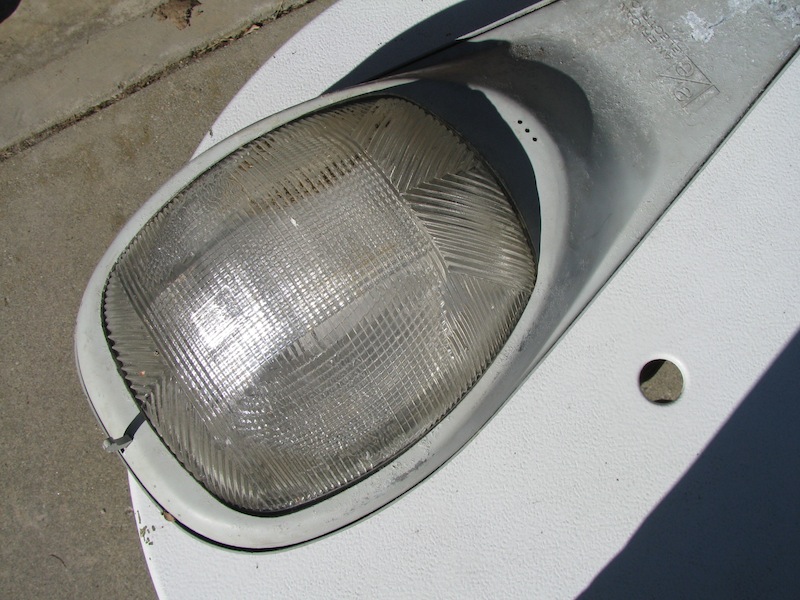 The insides.  The mercury vapor bulb.  One view of the wiring to the terminal strip. 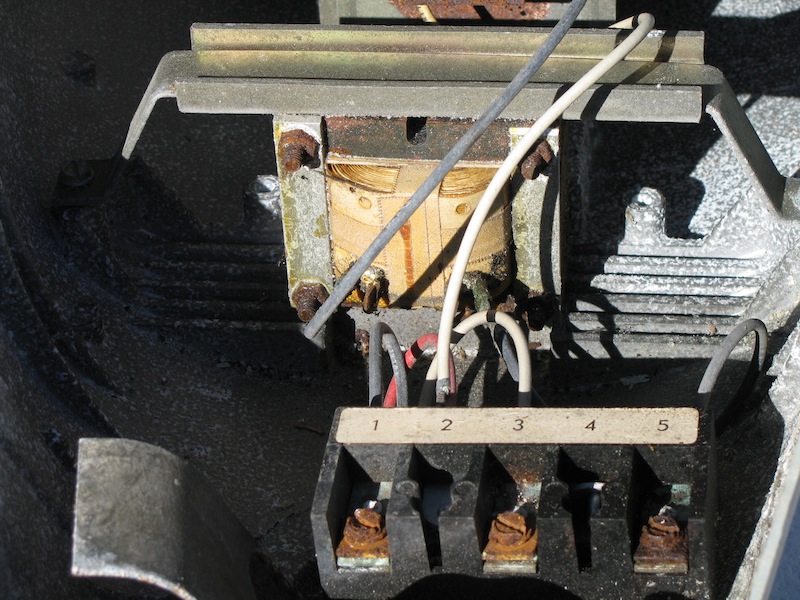 Another view. 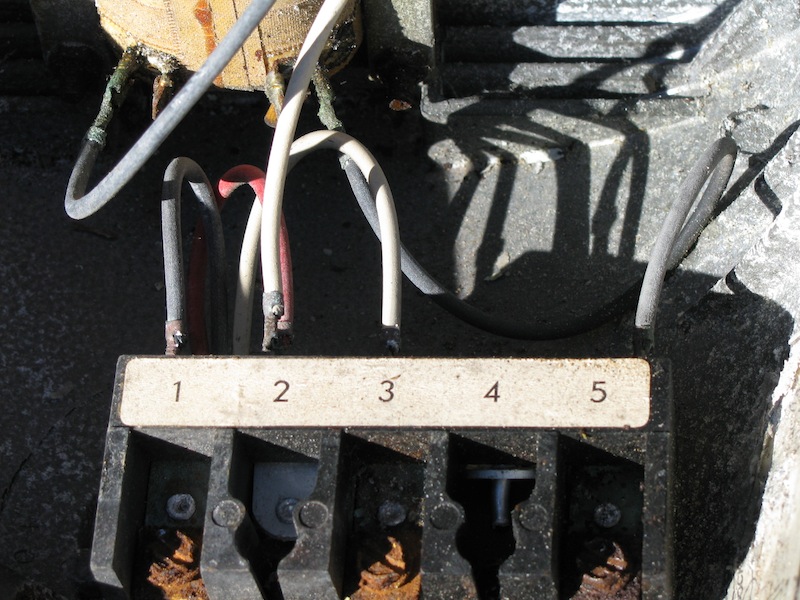 Yet another view. 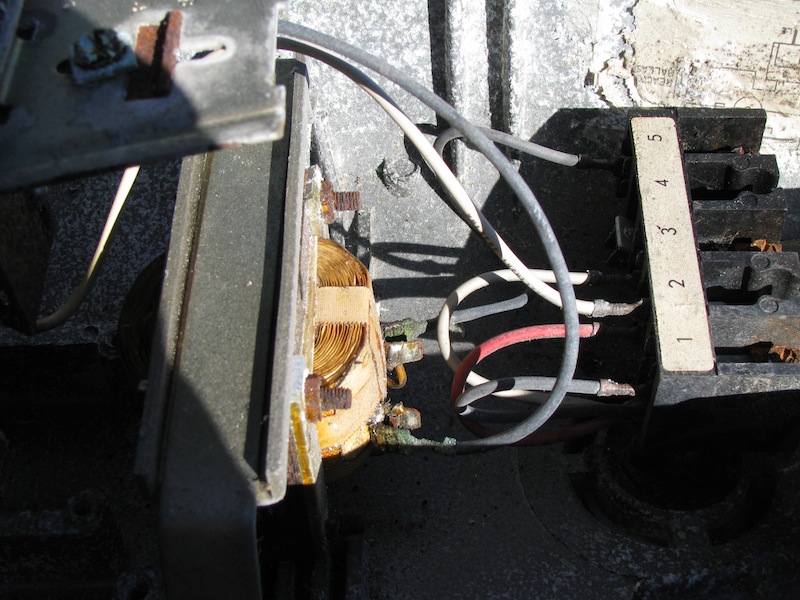 The top cover and insides of the photosensor module, which is a Fisher-Pierce. Note the gap in what I'm guessing is the photocell holder. 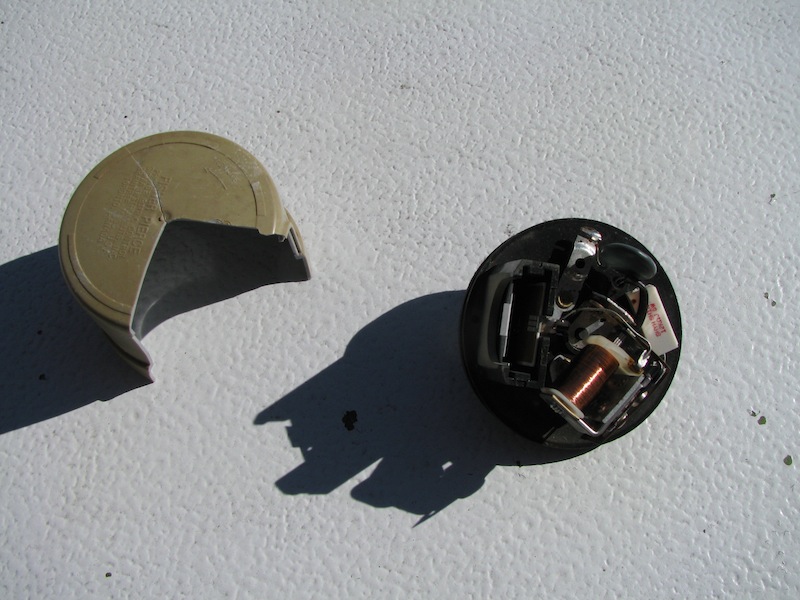 The bottom of the photosensor module. 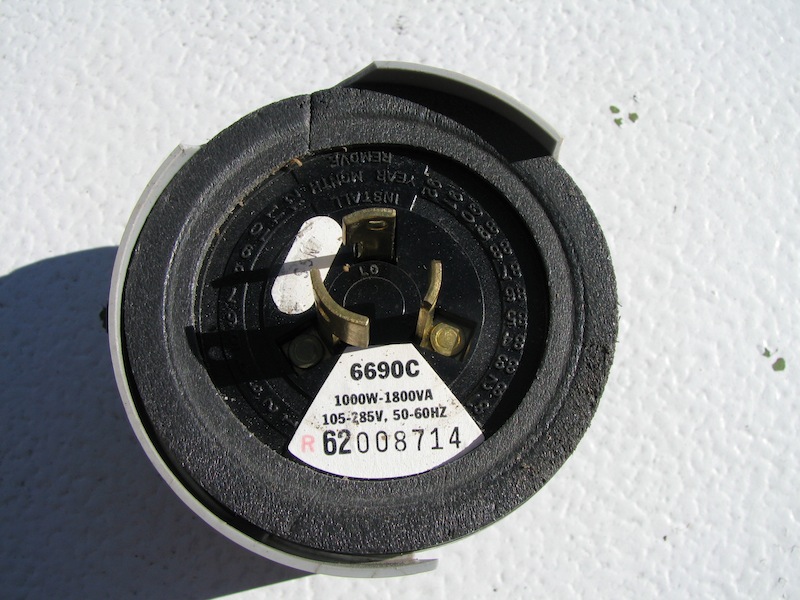 The underside of the socket for the photosensor module. 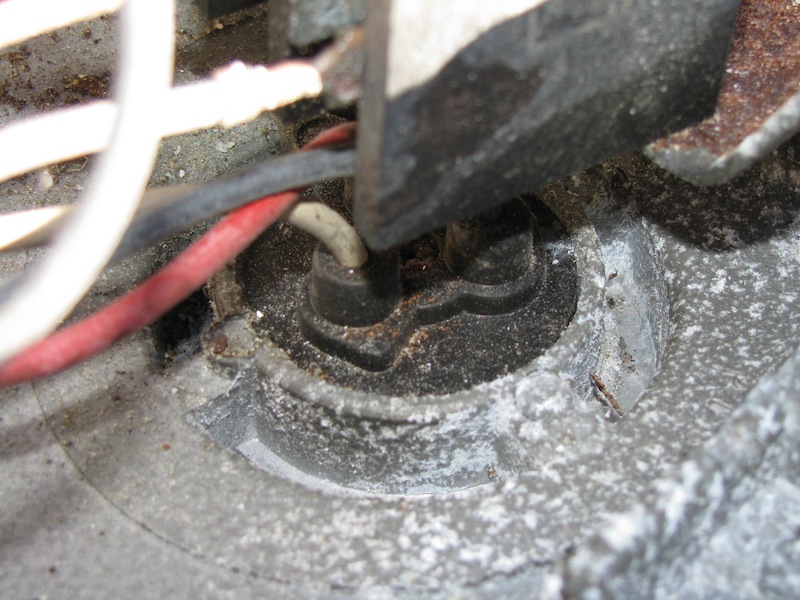 I hope these help. If anyone wants a view of something specific, please let me know. -Adam |
|
|
|
 Logged
Logged
|
|
Nevada Willis
Member
 
Offline
Gender: 
View
Posts
View Gallery

|
| Adam,
Not trying to butt in here, but looking at the connections and the photo control specs, here's what I suspect.
The lamp and photo control both work on 220v although the wiring appears to be set up for a 110v photo control as the control's white lead is run to terminal 3 and is looking for a neutral. However you should be able to move the control's white lead to terminal 5 in order to make it run on 220 without a neutral.
You may have to adapt a dryer cord or some other means to get 220 to the lamp to test it. Make sure your connections are good. If opposite legs of 220v touch, it will throw quite a spark! PB Blaster (available from WalMart automotive dept. or chain auto parts stores) is great for soaking and freeing up frozen terminal screws. Use a really good (not rounded off) properly sized screwdriver to protect the screw slots. Work sticky screws back and forth, adding lubricant, so as not to snap them off!
Typical wiring from what I've worked on-
Terminals 1 & 5: each leg of 220. It looks to me from the photos that 1 goes to the photo control socket and 5 goes to the ballast. That would mean...
Terminal 2: switched output from photo control.
Check the wiring. If the leads go where I suspect, then you can bypass the photo control and test the lamp by moving the light colored socket lead from terminal 2 to terminal 1, then apply 220v to terminals 1 and 5. If the ballast is good and the lamp isn't completely shot it should try to fire. If that works you can try moving the socket lead back to terminal 2, reinstall the photo control and power up leads 1 & 5, although from the looks of it, you might want to find an intact photo control.
Remember these ballasts are in series with the lamps. If there isn't enough voltage to fire an arc or if the lamp is bad, you won't get any hum or magnetic effect from the ballast.
I hope this information is useful.
|
|
|
« Last Edit: April 23, 2011, 07:35:01 PM by Nevada Willis »
|
 Logged
Logged
|
":O) Willis
|